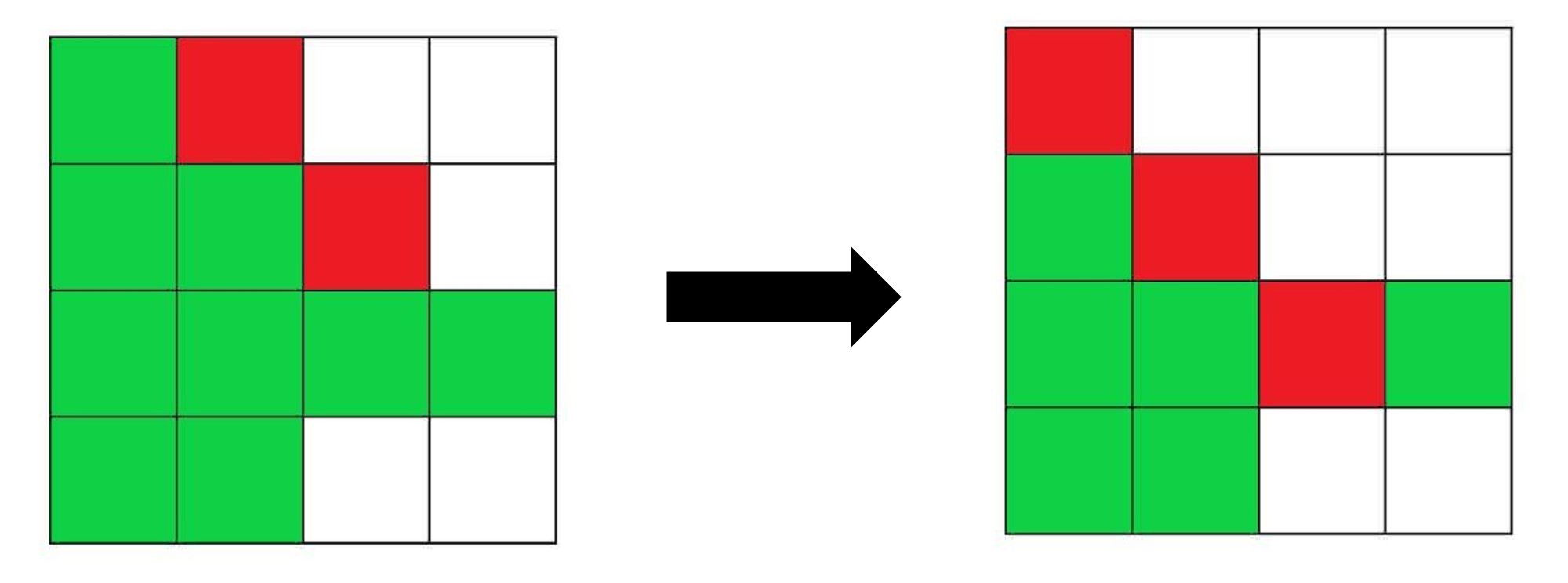A Cellular Automata Based Forest-Fire Model
Introduction
One of the first versions of a self-organized critical forest-fire model goes back to Drossel und Schwabl(1992). They define a cellular automata-based approach for a critical forest-fire model. The grid has N=Ld cells with a sidelength of L and a dimension d. Every cell can have three different states: Occupied by a Tree, burning or empty. The model is defined by four different rules, which are executed simultaneously:
- A tree grows on an empty cell with a probability p
- A tree ignites with a probability f
- A tree will burn if one of its neigbours is on fire
- A burning cell turn into an empty cell

The picture on the left shows one step of the Forest-fire model. Red cells are burning trees, green cells are occupied by trees and white cells are empty. It is also important to note that the simulation and the example use the Von-Neumann neighborhood, to compute the next state of the grid. The Von Neumann neighborhood contains only the four next cells. The model becomes critical in the limit f → 0.
Instructions
The simulation takes place on a 30x30, 50x50, or 70x70 grid and is initialized with 25% trees and no burning cells. The grid size can be chosen according to the power of the computer. Green cells represent trees, red cells represent fire and black cells are empty. Toroidal boundary conditions were chosen. The parameters p and f are given as multiples of 1/Ld. Initially, p and f are chosen to be p = 30 and f = 0.1. The values of the parameters can be changed at any time with the respective sliders. To start, stop, or reset the simulation just press the respective button. If only a single time step is to be calculated, the button "Update Grid" can be pressed. The repetition rate of the simulation can be altered using the FPS slider. The adjacent graph shows the percentage of trees in the total grid in real-time. It is also possible to introduce lightning strikes by clicking on the cells. This can be done while the simulation is running and paused.
Simulation
p =
f =
Theory

Fig.1 : The average number of clusters N and average cluster radius R as a function of cluster size s. From [2]
The forest fire model from Drossel and Schwabl(1992) is a self-organized critical system, which means that it evolves into the critical state from a large number of parameters. In order to show criticality a separation of timescales is needed. Therefore the time it needs to grow a tree 1/p must be much shorter than the occurrence of a lightning strike 1/f. In the critical state, the cluster size distribution of forest patches is scale-invariant, which means the cluster size is power-law distributed. The critical state is organized in the sense that the number of growing trees and burning trees is maximized. In these stable states, the fire density is constant. In the model, the parameters f and p can be combined to only on relevant parameter f/p, because if both parameters multiplied by the same factor only the time scale of the dynamics are changed.
The live simulation can only take place on a small grid due to the required computing power. Therefore to see the different behaviors of the model can be difficult. For this reason, you can watch the the emergence of large spirals and the steady-state on an larger grid in the videos below. In the videos, a 300 x 300 grid was iterated. The spirals are shown in the right video and occurred with f/p = 1/200. The steady-state can bee seen in the left video and occurs with f/p = 1/10.
References
- Wikipedia Forest-fire_model
- Drossel, B.; Schwabl, F. (1992-09-14). "Self-organized critical forest-fire model". Physical Review Letters. American Physical Society (APS). 69 (11): 1629–1632.